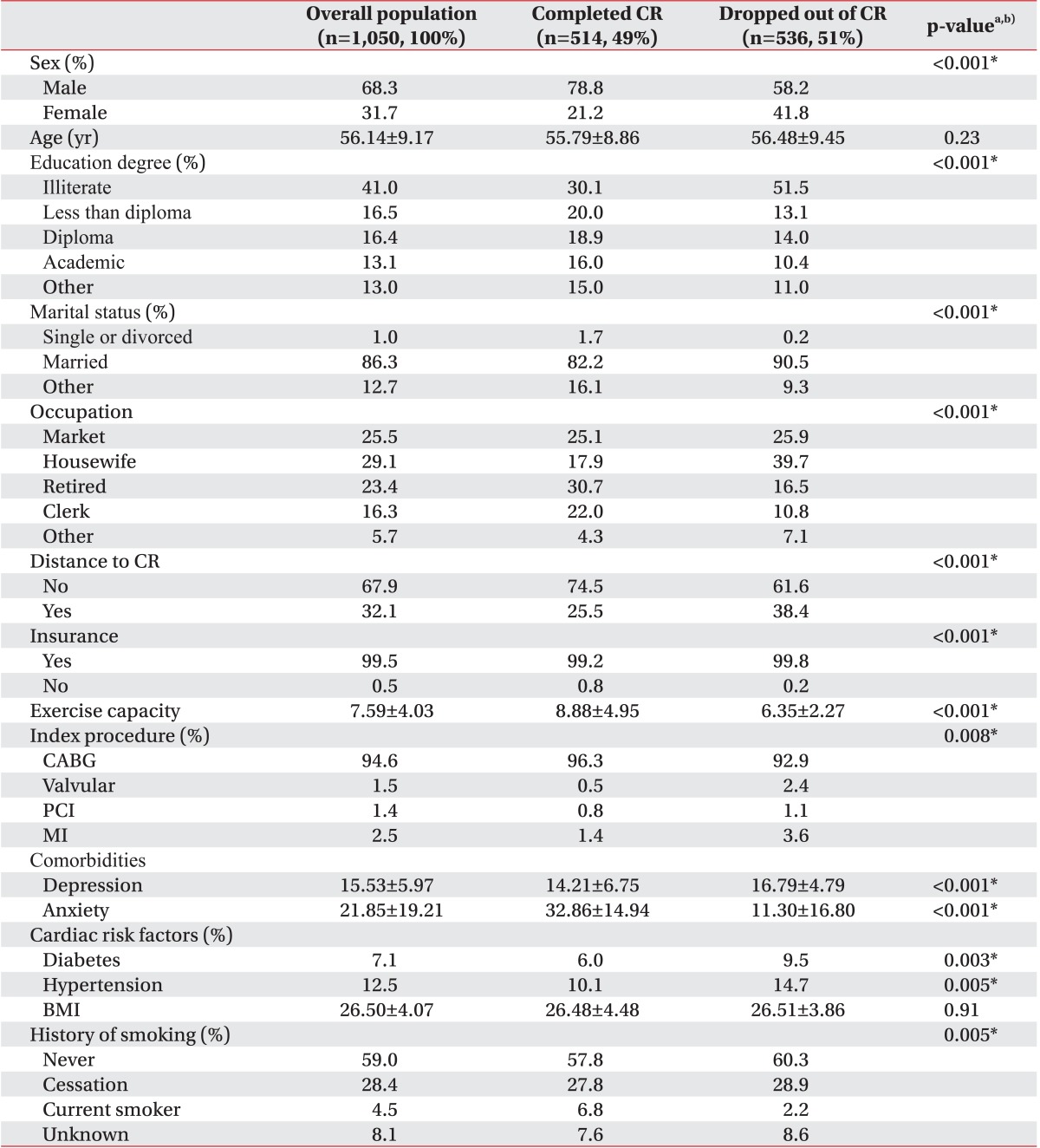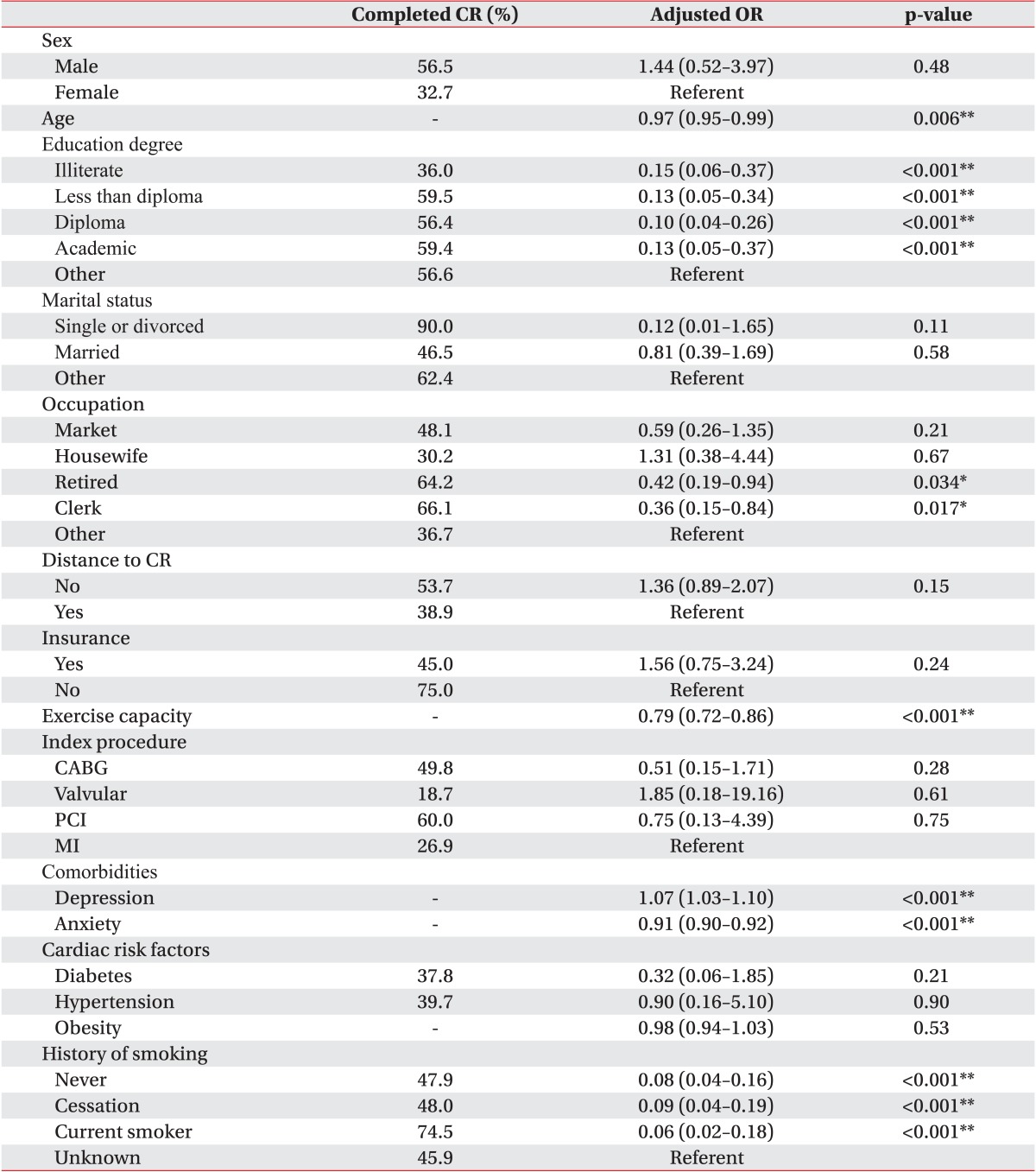1. Karami J, Komasi S, Maesoomi M, Saeidi M. Comparing the effects of two methods of relaxation and interpersonal cognitive problem solving (ICPS) on decreasing anxiety and depression in cardiac rehabilitation patients. Urmia Med J. 2014; 25:298–308.
2. Hajali Akbari Z, Hosseini MA, Nourozi K, Rahgozar M. Comparing barriers and facilitators of attending to cardiac rehabilitation programs from patients with coronary artery bypass graft surgery and rehabilitation specialists' viewpoints. Iran J Rehabil Res Nurs. 2014; 1:62–73.
3. Bath J, Bohin G, Jones C, Scarle E. Cardiac rehabilitation: a workbook for use with group programmes. Chichester: John Wiley & Sons;2009.
4. World Health Organization. Needs and action priorities in cardiac rehabilitation and secondary prevention in patients with coronary heart disease. Geneva: World Health Organization;1993.
5. Proudfoot C. Cardiac rehabilitation. In : Thow MK, editor. Exercise leadership in cardiac rehabilitation: an evidence-based approach. Chichester: John Wiley & Sons;2006. p. 9–13.
6. Williams MA, Ades PA, Hamm LF, Keteyian SJ, La-Fontaine TP, Roitman JL, et al. Clinical evidence for a health benefit from cardiac rehabilitation: an update. Am Heart J. 2006; 152:835–841. PMID:
17070142.

7. Jackson L, Leclerc J, Erskine Y, Linden W. Getting the most out of cardiac rehabilitation: a review of referral and adherence predictors. Heart. 2005; 91:10–14. PMID:
15604322.

8. Witt BJ, Thomas RJ, Roger VL. Cardiac rehabilitation after myocardial infarction: a review to understand barriers to participation and potential solutions. Eura Medicophys. 2005; 41:27–34. PMID:
16175768.
9. Dohnke B, Nowossadeck E, Muller-Fahrnow W. Motivation and participation in a phase III cardiac rehabilitation programme: an application of the health action process approach. Res Sports Med. 2010; 18:219–235. PMID:
21058208.

10. Moradi B, Maleki M, Esmaeilzadeh M, Bakhshandeh Abkenar H. Physician-related factors affecting cardiac rehabilitation referral. J Tehran Heart Cent. 2011; 6:187–192. PMID:
23074367.
11. Moradi B, Esmaeilzadeh M, Maleki M, Sari L. Factors associated with failure to complete phase II cardiac rehabilitation: survey registry in Rajaie cardiovascular medical and research center. Int Cardiovasc Res J. 2011; 5:139–142.

12. Oldridge NB, Guyatt GH, Fischer ME, Rimm AA. Cardiac rehabilitation after myocardial infarction. Combined experience of randomized clinical trials. JAMA. 1988; 260:945–950. PMID:
3398199.

13. Taylor GH, Wilson SL, Sharp J. Medical, psychological, and sociodemographic factors associated with adherence to cardiac rehabilitation programs: a systematic review. J Cardiovasc Nurs. 2011; 26:202–209. PMID:
21076307.
14. Beck AT, Epstein N, Brown G, Steer RA. An inventory for measuring clinical anxiety: psychometric properties. J Consult Clin Psychol. 1988; 56:893–897. PMID:
3204199.

15. Beck AT, Steer RA, Garbin MG. Psychometric properties of the Beck Depression Inventory: twenty-five years of evaluation. Clin Psychol Rev. 1988; 8:77–100.

16. Sarrafzadegan N, Rabiei K, Shirani S, Kabir A, Mohammadifard N, Roohafza H. Drop-out predictors in cardiac rehabilitation programmes and the impact of sex differences among coronary heart disease patients in an Iranian sample: a cohort study. Clin Rehabil. 2007; 21:362–372. PMID:
17613578.
17. Lavie CJ, Milani RV, Lavie TJ. Impact of cardiac rehabilitation, exercise training, and fitness on psychological distress. In : Sher L, editor. Psychological factors and cardiovascular disorders: the role of stress and psychological influences. New York: Nova Science Publishers Inc.;2009. p. 314–320.
18. Blanchard CM, Courneya KS, Rodgers WM, Fraser SN, Murray TC, Daub B, et al. Is the theory of planned behavior a useful framework for understanding exercise adherence during phase II cardiac rehabilitation? J Cardiopulm Rehabil. 2003; 23:29–39. PMID:
12576910.

19. Sanderson BK, Phillips MM, Gerald L, DiLillo V, Bittner V. Factors associated with the failure of patients to complete cardiac rehabilitation for medical and nonmedical reasons. J Cardiopulm Rehabil. 2003; 23:281–289. PMID:
12894002.

20. Grace SL, Shanmugasegaram S, Gravely-Witte S, Brual J, Suskin N, Stewart DE. Barriers to cardiac rehabilitation: DOES AGE MAKE A DIFFERENCE. J Cardiopulm Rehabil Prev. 2009; 29:183–187. PMID:
19471138.
21. Worcester MU, Murphy BM, Mee VK, Roberts SB, Goble AJ. Cardiac rehabilitation programmes: predictors of non-attendance and drop-out. Eur J Cardiovasc Prev Rehabil. 2004; 11:328–335. PMID:
15292767.

22. Mikkelsen T, Korsgaard Thomsen K, Tchijevitch O. Non-attendance and drop-out in cardiac rehabilitation among patients with ischaemic heart disease. Dan Med J. 2014; 61:A4919. PMID:
25283618.
23. Grace SL, Gravely-Witte S, Brual J, Monette G, Suskin N, Higginson L, et al. Contribution of patient and physician factors to cardiac rehabilitation enrollment: a prospective multilevel study. Eur J Cardiovasc Prev Rehabil. 2008; 15:548–556. PMID:
18830085.
24. De Vos C, Li X, Van Vlaenderen I, Saka O, Dendale P, Eyssen M, et al. Participating or not in a cardiac rehabilitation programme: factors influencing a patient's decision. Eur J Prev Cardiol. 2013; 20:341–348. PMID:
22345682.

25. Yohannes AM, Yalfani A, Doherty P, Bundy C. Predictors of drop-out from an outpatient cardiac rehabilitation programme. Clin Rehabil. 2007; 21:222–229. PMID:
17329279.

26. van der Wal MH, Jaarsma T, Moser DK, Veeger NJ, van Gilst WH, van Veldhuisen DJ. Compliance in heart failure patients: the importance of knowledge and beliefs. Eur Heart J. 2006; 27:434–440. PMID:
16230302.

27. American Psychiatric Association. Diagnostic and statistical manual of mental disorders (DSM-5). 5nd ed. Washington: American Psychiatric Association;2013. p. 233–250.
28. Vaccarino V, Bremner JD. Psychiatric and behavioral aspects of cardiovascular disease. In : Bonow RO, Mann DL, Zipes DP, Libby P, editors. Braunwald's Heart disease: a text book of cardiovascular medicine. 9th ed. Philadelphia: Saunders;2012. p. 1904–1915.
29. Michie S, O'Connor D, Bath J, Giles M, Earll l. Cardiac rehabilitation: The psychological changes that predict health outcome and healthy behaviour. Psychol Health Med. 2005; 10:88–95.

30. Turk-Adawi KI, Oldridge NB, Tarima SS, Stason WB, Shepard DS. Cardiac rehabilitation enrollment among referred patients: patient and organizational factors. J Cardiopulm Rehabil Prev. 2014; 34:114–122. PMID:
24142042.
31. Fischer MJ, Scharloo M, Abbink JJ, van't Hul AJ, van Ranst D, Rudolphus A, et al. Drop-out and attendance in pulmonary rehabilitation: the role of clinical and psychosocial variables. Respir Med. 2009; 103:1564–1571. PMID:
19481919.

32. Grace SL, Gravely-Witte S, Brual J, Suskin N, Higginson L, Alter D, et al. Contribution of patient and physician factors to cardiac rehabilitation referral: a prospective multilevel study. Nat Clin Pract Cardiovasc Med. 2008; 5:653–662. PMID:
18542104.







 PDF
PDF ePub
ePub Citation
Citation Print
Print


 XML Download
XML Download